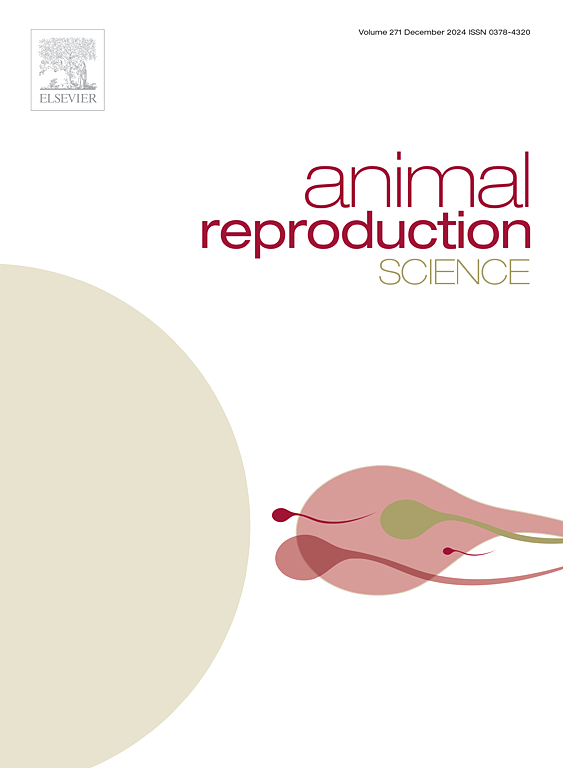高、低产蛋率母鸡卵巢非编码rna的综合分析
IF 2.2
2区 农林科学
Q1 AGRICULTURE, DAIRY & ANIMAL SCIENCE
引用次数: 0
摘要
产蛋性能是家禽业的一个重要经济性状。非编码rna介导的产蛋性能的调控机制仍有待研究。为了系统地研究与产蛋效率相关的卵巢lncRNAs、circRNAs和miRNAs,我们利用RNA测序(RNA-seq)对高产蛋量(HEP)和低产蛋量(LEP)母鸡的卵巢组织进行了比较转录组分析。在我们的研究中,我们确定了675个lncrna, 140个circrna和10个mirna在HEP和LEP之间显着表达差异(DE)。基因本体(GO)和京都基因与基因组百科全书(KEGG)分析显示,DE lncRNAs的靶基因、DE miRNAs的靶基因和DE circRNAs的源基因参与了MAPK信号通路、内吞作用、notch信号通路等。此外,我们鉴定了5种与产蛋相关的miRNA-mRNA相互作用,包括gga-miR-449c-3p和5个基因(GLI2, TAC1, EML6, THOC3, MMP9)。这些发现建立了第一个全面的驱动卵巢效率的ncRNA相互作用组,为育种选择和生殖增强的机制靶点提供了生物标志物。本文章由计算机程序翻译,如有差异,请以英文原文为准。
Comprehensive analysis of non-coding RNAs in the ovaries of high and low egg production hens
Egg production performance a critical economic trait in the poultry industry. The regulatory mechanisms underlying egg production performance mediated by non-coding RNAs remain to be characterized. To systematically investigate ovarian lncRNAs, circRNAs, and miRNAs associated with laying efficiency, we conducted comparative transcriptomic analyses using RNA sequencing (RNA-seq) of ovarian tissues from phenotypically divergent groups - high egg production (HEP) and low egg production (LEP) hens. In our study, we identified 675 lncRNAs, 140 circRNAs, and 10 miRNAs that were significantly differentially expressed (DE) between HEP and LEP. Gene Ontology (GO) and Kyoto Encyclopedia of Genes and Genomes (KEGG) analysis showed that target genes of DE lncRNAs, DE miRNAs, and the source genes of DE circRNAs are involved in the MAPK signaling pathway, endocytosis, notch signaling pathway, among others. Furthermore, we identified five miRNA-mRNA interactions related to egg production including gga-miR-449c-3p, and five genes (GLI2, TAC1, EML6, THOC3, MMP9). These findings establish the first comprehensive ncRNA interactome driving ovarian efficiency, offering both biomarkers for breeding selection and mechanistic targets for reproductive enhancement.
求助全文
通过发布文献求助,成功后即可免费获取论文全文。
去求助
来源期刊

Animal Reproduction Science
农林科学-奶制品与动物科学
CiteScore
4.50
自引率
9.10%
发文量
136
审稿时长
54 days
期刊介绍:
Animal Reproduction Science publishes results from studies relating to reproduction and fertility in animals. This includes both fundamental research and applied studies, including management practices that increase our understanding of the biology and manipulation of reproduction. Manuscripts should go into depth in the mechanisms involved in the research reported, rather than a give a mere description of findings. The focus is on animals that are useful to humans including food- and fibre-producing; companion/recreational; captive; and endangered species including zoo animals, but excluding laboratory animals unless the results of the study provide new information that impacts the basic understanding of the biology or manipulation of reproduction.
The journal''s scope includes the study of reproductive physiology and endocrinology, reproductive cycles, natural and artificial control of reproduction, preservation and use of gametes and embryos, pregnancy and parturition, infertility and sterility, diagnostic and therapeutic techniques.
The Editorial Board of Animal Reproduction Science has decided not to publish papers in which there is an exclusive examination of the in vitro development of oocytes and embryos; however, there will be consideration of papers that include in vitro studies where the source of the oocytes and/or development of the embryos beyond the blastocyst stage is part of the experimental design.
 求助内容:
求助内容: 应助结果提醒方式:
应助结果提醒方式:


